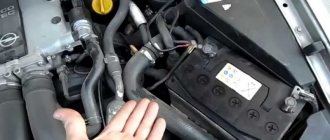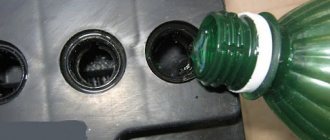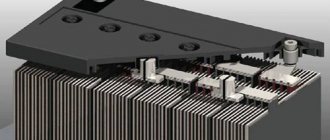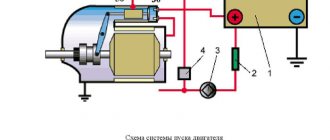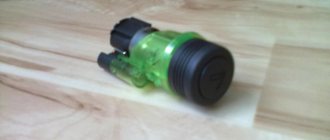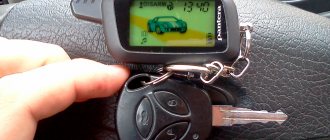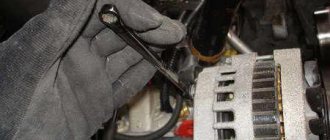Author: Evgeny Zhivoglyadov. Date of publication: August 11, 2022. Category: Automotive equipment.
The electrolyte is the main component of the battery, thanks to which the required amount of charge is accumulated and retained. The battery does not last forever (the service life is about 5-7 years, provided that it was purchased from a reliable manufacturer). However, sometimes car owners are faced with the fact that the battery fluid has acquired a cloudy or even black tint long before the end of the service life of this element.
The color of the new electrolyte can be compared to a child's tear. This is not surprising, because it consists only of distilled water and sulfur concentrate. Both components are completely transparent (if you look inside the battery through the open plugs, you can easily see the lead plates). If the power supply is working properly and there are no problems, then this color will not change for a very long time. If the liquid darkens or sediment appears, it is worth understanding the reasons for this manifestation and, if possible, correct the situation.
Cloudiness of the electrolyte
There are several reasons for this phenomenon. Many people believe that the whole issue is dust that got into the battery banks. However, this happens extremely rarely, especially when it comes to maintenance-free batteries, which are actually sealed containers. Therefore, we immediately cut off this reason.
If the liquid is cloudy, then it is worth remembering what kind of water was used when servicing the unit last time. You need to remember once and for all, you cannot use tap water, even if it looks very clean and transparent (and even more so process water). Only distilled liquid is suitable.
Sometimes the electrolyte remains relatively transparent, but inclusions appear in it, which form a precipitate. This indicates that we had to deal with sulfation of the plates.
If the liquid becomes cloudy and acquires a gray or lead-like tint, this indicates a severe discharge of the battery. Fortunately, all these problems can be solved on your own, without replacing the electrolyte or buying a new battery.
Healthy electrolyte concept
It is quite simple to explain why the electrolyte in its normal state should be transparent.
The liquid is based on distilled water and sulfuric acid. As you know, purified water is absolutely transparent. The same can be said about sulfuric acid, which does not have any characteristic color. When two components are connected, no changes occur either.
Mixing clear acid with clear water produces a completely clear electrolyte.
But sometimes there is a change in color or degree of transparency of the mixture. In this case, we have to talk about problems with the battery. Moreover, they are quite serious, requiring surgical intervention. It is not always possible to restore the battery and return it to work. Sometimes the only way out of the situation is to replace the battery.
Simple Troubleshooting
If you can determine that the battery is discharged, then in this case it is enough to connect the battery to the power supply and wait a while. As the charge is received, the liquid will restore its color.
When sulfating platinum, it is necessary to perform more complex manipulations. First you need to rub the battery a little. After that:
- Add a small amount of distilled water to the battery to bring the electrolyte level to normal.
- We connect the battery to the charger (it is recommended to set it for eight hours).
If during charging the electrolyte temperature exceeds 43 degrees, then it must either be kept at this level or reduced slightly. However, at this stage it is important to ensure that the voltage in one of the battery jars does not drop to a level below average (up to 0.2 V). If this happens, you must immediately stop the procedure and take the battery for repair or replace it.
Things are much worse if the electrolyte in one or several battery containers has not only lost its transparency, but has completely turned black. In this case, the problem is explained by the fact that the so-called coating of the plates (essentially lead oxide) of the battery has crumbled or the device was operated in a discharged state.
Natural shade of the mixture
In working condition, the battery solution will have a clear color - no dark areas or cloudiness. The composition of the mixture inside the housing consists of sulfuric acid and distillate. Both elements are neutral in color. If the electrolyte is of a different, cloudy or different color, then the battery is faulty. Changes can occur in one or all sections.
It is recommended to keep the mixture level in the battery 15-20 mm above the top level of the plates. In order to find out the current electrolyte level, you need to lower the “marker” into the battery to the plates. The marker can be, for example, a transparent tube (plastic or glass). To fill the tube with the mixture, you need to clamp it and measure the level using a ruler.
Blackening of the electrolyte
If the liquid has acquired an alarmingly dark color, then you should first consider the possibility of shedding of the spread. In half the cases of such problems, everything is explained by the fact that the electrodes are covered with rust due to their advanced age. Constantly collapsing, they began to partially turn into dust, which settled in the separator bags. In such situations, as soon as the battery receives a charge, boiling occurs, during which what was once a lubricant begins to spread throughout the jar.
If a discharged battery was used, this could also lead to shedding of this material (which happens in 50% of cases). The fact is that, in terms of its chemical composition, a discharged coating (not yet crumbled) differs from a charged one. In the first case, it does not stay on the plates for long and quickly crumbles. This explains why it is strictly forbidden to shake a discharged battery vigorously.
Interesting! During the war years, tankers could be court-martialed if they let their battery discharge by more than 25%.
There are also opposite situations when the battery experiences too much voltage (about 15-16 Volts). In this case, the electrolyte begins to boil with such force that the grease falls off the plates of even a newly purchased battery. Overheating can also be caused by a malfunction of the generator or the voltage regulator. Often, such consequences are caused by the “tricks” of drivers who use homemade devices of dubious quality to charge.
Important! The temperature of the fluid in the battery cannot exceed 40 degrees. Otherwise, a chemical reaction or boiling will begin. Because of this, the electrolyte loses all its qualities and changes color.
But what to do if the liquid has become very dark? First of all, you need to check whether this happened in only one part of the battery or in the entire battery.
If the color of the electrolyte in the battery has darkened and turned black or red
"Hello!
I put the battery on charge, after 2 hours I went to measure the density, and the electrolyte darkened. What is this?" “I put the battery on charge, charged it for about two hours. Then I discovered that the electrolyte had turned some kind of gray color. The current is 10% of the capacity, I can’t understand what’s wrong, why has it become darker?” An electrolyte is a mixture of sulfuric acid and water. The normal color of electrolyte is clear, like water.
If the color of the electrolyte is gray (lead), this means that the battery is very discharged. By charging such a battery, we will achieve transparency of the electrolyte.
Also, in the case of sulfation of the plates, suspension will be observed in the electrolyte. The electrolyte itself does not change color; it is still transparent, but it is noticeable that there is a foreign suspension in it. Typically, an anti-sulfation program dissolves this suspension and the electrolyte becomes completely transparent again.
If in one or, what is much worse, in several banks, the electrolyte has lost its transparency, become cloudy or even changed color to black - this means a catastrophic shedding of the grease (lead oxide) from the plates. Such a battery cannot be repaired or restored, but is disposed of.
Why does the coating crumble? In 50% of cases this is an old battery. The electrodes rusted from age, fell apart, and this rot remained in separator bags. When a charge current was applied to such a battery, the boiling of the electrolyte stirred and spread throughout the entire jar, what was once a spread.
Operating a discharged battery accounts for the second 50% of cases of grease shedding. The chemical composition and characteristics of the discharged grease on the plates are different from those of the charged one
It is important for the consumer to know that the grease in a discharged battery adheres very weakly to the plates. If you shake a discharged battery, you will get cloudy electrolyte and, in fact, a damaged battery
By the way, in the Soviet army during World War II, tank crews, under the threat of a tribunal, were forbidden to have batteries in their vehicles that were discharged by more than 25%.
An increased charge voltage (15-16 Volts) also causes the electrolyte to boil. In such a situation, the coating will peel off even from the plates of a new battery.
If the electrolyte turns red, this means that the jar has been reversed and the fluffs have come out of the lubricant. Which also means you have to recycle that battery.
The electrolyte may become cloudy due to adding undistilled water (tap water, snow, etc.). The electrolyte will darken if the battery was used with the plugs unscrewed and dirt got inside.
Important! In a normal battery, the electrolyte should be transparent
Dear visitors! If you wish, you can leave your comment in the form below.
Attention! Advertising spam, messages that are not related to the topic of the article, that are offensive or threatening, that call for and/or incite ethnic hatred will be deleted without explanation. If you have access to the banks, unscrew the plugs and load the battery with a 200 Amp load fork
If you see “boiling” in one of the cans (the one with a cloudy electrolyte), it means the plates are broken - short circuit. A short circuit is basically a warranty case. Demand a replacement. If there is no short circuit, then the second stage is to check which cans boil when charging? Connect the battery to the charger. If there are bubbles in some jars and not in others, this is an imbalance of the jars. Also very bad, but not a warranty case. Due to different internal resistances, the total charge voltage in an unbalanced battery is not equally divided between the banks. Some are overcharged: for example, which is cloudy (torn-off particles of lubricants) or spongy lead (rags), while others are undercharged: you won’t see a single bubble in these. In both cases you need a new battery
If you have access to the banks, unscrew the plugs and load the battery with a 200 Amp load fork. If you see “boiling” in one of the cans (the one with a cloudy electrolyte), it means the plates are broken - short circuit. A short circuit is basically a warranty case. Demand a replacement. If there is no short circuit, then the second stage is to check which cans boil when charging? Connect the battery to the charger. If there are bubbles in some jars and not in others, this is an imbalance of the jars. Also very bad, but not a warranty case. Due to different internal resistances, the total charge voltage in an unbalanced battery is not equally divided between the banks. Some are overcharged: for example, which is cloudy (torn-off particles of lubricants) or spongy lead (rags), while others are undercharged: you won’t see a single bubble in these. In both cases you need a new battery.
1 jar is cloudy and in the last one there are rags floating around. Used for 6 months. The seller says it’s normal, but the neighboring seller says it’s rubbish.
In one or all banks
If the composition of only one jar becomes cloudy and blackened, you need to work with this particular container. First of all, it is recommended to check the voltage in it. It should be about 2.1 Volts. If the indicator of the “affected” bank fluctuates around 0.5 Volts or there is no voltage in it at all, while in the entire battery it is 10-10.5 V, then with a probability of 90% you can be sure that the capacity has “crumbled”, that is, the lead did not stay on the plates and fell into an unpleasant black precipitate. As soon as it starts to touch the plates, the voltage on them disappears and the can stops working. In this case, you can rack your brains about restoring such a battery, but most likely you will have to replace it.
If the liquid has become cloudy in all containers, then in this case you will have to completely replace the electrolyte. If after this it remains transparent, then most likely the cause of the previous color change lies in poor quality water.
Before moving on to drastic actions, it is worth trying to remove the dregs in the simplest way - try charging the battery (it is best to use a device for this that has a plate desulfation function). After this, you need to check the voltage at the terminals. If it is below 12.7V, then such an electrolyte cannot be saved. With a higher rate, you can count on the battery to last a little longer, but the battery capacity will be significantly lower.
How to solve a problem
First of all, the solution in all jars is inspected. The substance can be black, cloudy or even gray.
The next step is to determine which banks have the problem - all or certain ones. After diagnosis, the problem itself is solved.
The solution became cloudy in all jars
There are two reasons. The first is the use of low-quality solution. To solve the problem, you just need to replace the fluid with a high-quality one. To do this, pour out the old one and fill in new working fluid.
If the problem is not solved, then the second reason is to blame - not distilled water.
The solution is replaced again, only using distillate.
Gray solution in all jars
The most common cause is deep discharge. Gray color is a sign of precipitation in the form of salt crystals. If after charging the solution does not become clean and transparent, then you need to replace it with a new one.
The electrolyte has become cloudy or blackened in certain jars
If the liquid turns black in one jar, but the rest are fine, then the problem can be solved by manipulating only the damaged one.
First, the exact problem is diagnosed. To do this, it is advisable to use a tester to find out what voltage this jar produces. The permissible voltage is 2-2.1 V. Often with such symptoms, the voltage is either weak or completely absent.
This means one thing - damage and shedding of the plates. The reasons why this happens are described above.
The color changes due to lead deposition. Lead gives the substance its black color. In this case, little will help. You'll have to go to the store and buy a new battery.
Electrolyte replacement
If manipulations with charging do not produce any results, then we move on to more effective measures. To do this, you first need to purchase a new electrolyte. In the store composition, the density is 1.31-1.34 g/cm3. However, for operation you will need an electrolyte with a lower value (1.27-1.29 g/cm3). To achieve this result, the finished composition is diluted with a small amount of distillate. After that:
- We clean the outer part of the battery case (so as not to accidentally introduce dirt into the jars during the process of replacing the fluid).
- We unscrew the caps of the cans (all) and remove the cloudy electrolyte.
Healthy! If you are trying to replace the fluid in a maintenance-free battery, you also need to pry it with two screwdrivers and remove the hydrometer (eye).
- We wash the inside of the battery so that there is no sediment left in the jars (you can only use distilled water and chemical cleaning fluids).
- We pour new electrolyte into the battery compartments and set it to charge at a current of 2A. During charging, the voltage should be checked periodically.
When the battery is fully charged, it is necessary to evaluate the quality of the solution, its density and level. The composition should cover all plates in each jar. At the same time, its density should remain at the same level (1.27-1.29 g/cm3). If after some time this indicator decreases, you will have to completely replace the battery.
Why does the battery fluid darken?
Battery electrolyte is a mixture of distilled water and concentrated sulfuric acid. The initial color of both liquids is transparent, and it remains so after mixing. Being inside a working power source, the solution does not change its natural color and continues to remain transparent.
Reference. If you look into a working serviceable battery through one of the open plugs, you can see lead plates - a clean electrolyte allows this to be done.
When the sulfuric acid solution becomes cloudy or turns black, there is a battery malfunction due to a violation of the structure of the plates. Unfortunately, the vast majority of car enthusiasts pay attention to the color of the liquid after the manifestation of more tangible signs - unexpected battery discharge, boiling over, and so on.
If the electrolyte in the battery has become cloudy or blackened, the following reasons should be considered:
- the lead filler has begun to shed from the plates, at an early stage the liquid becomes cloudy and then turns black;
- Dirt has gotten inside the power source being serviced, causing a cloudy sediment to appear;
- the car owner accidentally added ordinary water, low-quality distillate or electrolyte of unknown origin to the cans;
- battery overheating;
- the plates received excessive charging voltage over a long period (called overcharging).
Dirt in the battery is a fairly rare cause of darkening of the solution. It takes a lot of effort to introduce foreign particles into the electrolytic liquid. On maintenance-free products, dirt ingress is virtually eliminated.
Cloudiness due to adding the wrong solution, overheating or overcharging is much more common. In the first case, a chemical reaction provokes the precipitation of foreign inclusions, which floats in the electrolyte and creates turbidity. Overheating can occur due to a malfunction of the car alternator and voltage regulator, as well as when charging the battery with a powerful homemade device.
Reference. The maximum permissible temperature of the electrolytic fluid during battery operation is 40 °C. When heated above the specified value, the solution begins to lose its chemical properties and becomes cloudy.
Bad advice
The Internet is full of advisors who give ridiculous solutions to problems, and there are several myths floating around. Under no circumstances should you adhere to them, because such advice can kill the battery.
Here are some of them:
- Use snow instead of distillate. Snow is not distilled water. Adding it to the electrolyte causes breakdown.
- If lead precipitation occurs, pour out the electrolyte, rinse the jar with water and fill with a new substance. This was practiced in the last century. Modern battery banks have tightly spaced electrodes on which separator bags are stretched. It is impossible to pump out liquid with lead sediment from such jars. The pieces will not pass through the electrodes.
- Some sites sell so-called modifiers. According to the manufacturers, the products easily clean the electrolyte and extend the life of the battery. But these devices are the same as technologies that reduce fuel consumption. They do not work.
Sources
- https://remam.ru/elektrik/stal-mutnyj-elektrolit-v-akkumulyatore.html
- https://IstochnikiPitaniy.ru/akkumulyatory/avtomobilnye/mutnyj-elektrolit.html
- https://DriverTip.ru/zhizn/mutneet-elektrolit-v-akkumulyatore-kak-ispravit.html
- https://autochainik.ru/mutnyy-elektrolit-v-akkumulyatore.html
- https://avto-moto-shtuchki.ru/avtotekhnika/276-pomutnel-ili-pochernel-elektrolit-akkumulyatora.html
- https://3batareiki.ru/akkumulyatory/avtomobilnye-akkumulyatory/pri-zaryadke-akkumulyatora-pomutnel-elektrolit
Cloudiness during charging
Sometimes the driver removes the battery or connects the charger directly in the engine compartment. This is required to replenish the required charge level, since during short trips over short distances the generator does not have time to fully replenish the battery. But it is during charging that for some reason the electrolyte inside the battery becomes cloudy.
In the vast majority of cases, cloudy electrolyte during charging is caused by incorrectly set charging current.
All specialists and ordinary experienced motorists know that charging is always carried out at 10% of the current of the battery’s rated capacity.
However, this procedure usually takes about 10 hours.
If the liquid darkens during charging, check that the charger is set correctly and make sure that you are not over-charging the battery.
Cloudiness and discoloration of the working fluid in the battery cannot be called a pleasant phenomenon. Yes, this is not always critical, and sometimes the situation can be changed by partially replacing the working electrolyte in one of the available cans.
It is extremely important to monitor the state of the mixture of acid and distilled water, maintain optimal proportions between acid and water, and also do not forget to periodically check the charge level in the battery. It is not always possible to replenish it through the operation of the generator. Therefore, having a charger often helps to get out of the current difficult situation.
It’s never a bad idea to have a container with electrolyte and regular high-quality distilled water on hand. But all this is relevant only if there is a serviceable type of battery under the hood of your car.
Why does cloudy electrolyte appear when charging?
If the electrolyte darkens during charging, then almost always the cause of the change in color of the liquid is an incorrectly set current level on the charger. It is recommended to charge batteries for passenger cars with a current of no more than 10 percent of the nominal capacity of the device.
The battery should be charged within 10 hours, so leaving the charger connected for a longer period of time can cause the acidic liquid to become cloudy. Do you still have questions about the cloudy electrolyte or have something to add? Then write to us about it in the comments, this will make the material more useful, complete and accurate.
Reasons why the electrolyte is cloudy
In some cases, the transparent electrolyte begins to take on a cloudy tint. Why does this happen and how can you eliminate the problems associated with it?
The electrolyte may become cloudy for the following reasons:
- Dirt getting into the battery. This is the most common cause of darkening of the mixture;
- Adding water with foreign impurities. Sometimes the water may contain high levels of chlorine or iron, which will affect the appearance of the solution;
- Use of low-quality electrolyte. Most often, this problem occurs when you independently add a low-quality solution;
- Recharging the battery. In this case, a color change may occur due to the penetration of parts of the grease from the electrodes into the electrolyte. The main reason for overcharging is a faulty generator, as well as charging with low-quality chargers, poor operation of the relay - the “pill” regulator, or constant use of the battery, since in this mode it does not have time to cool;
- Temperature increase. This problem is relevant in the summer, since in extreme heat the electrolyte can become very hot. A temperature of more than 35-37 degrees is considered catastrophic for it, at which the processes leading to wear of the electrodes are most strongly activated;
- Replacing distilled water with tap water. Tap water contains impurities and metals, which cause the electrodes to fail faster;
- Constantly discharged battery. For this reason, the density of the substance decreases, it changes appearance, and the energy characteristics of the battery are greatly reduced;
- Defrosting the battery. This problem is typical in winter, when after severe freezing, the monoblock bursts during the defrosting process of the battery. Very often, after thawing, the electrolyte begins to leak out.
Let's sum it up
As you can see, cloudy or gray electrolyte is not always a sign of final battery failure without the possibility of recovery. In this case, you need to take a comprehensive approach to the maintenance issue, that is, wash the sections, fill in fresh electrolyte according to the level, and adjust the density. Next, you need to properly charge the battery.
It turns out that if the gray electrolyte is not yet so critical, the black electrolyte in the jars is already a good reason to scrap the existing battery and purchase a new battery. We also note that if there are problems with the generator in the car itself or when charging from the charger the battery is not charged correctly, then the new battery will quickly fail.
Replacing the electrolyte in a car battery: why and when the procedure is needed. How to properly drain the battery and change the electrolyte yourself. Battery charge.
Correctly charging a car battery with a charger. Before charging, check what current to charge the battery with. How to charge a battery without a charger.
How is the density of electrolyte in a battery measured, what does this indicator depend on. Affordable ways to increase the density in battery “banks” with your own hands.
When to charge a maintenance-free car battery. How to charge a maintenance-free battery with a charger: current strength, charging time. Adviсe.
How to restore functionality to a car battery if it is frozen. Why does the electrolyte freeze in the battery, how to defrost and charge the battery.
Purpose, design and principle of operation of a car lead-acid battery.
